lock CADILLAC CT4 2021 Owner's Guide
[x] Cancel search | Manufacturer: CADILLAC, Model Year: 2021, Model line: CT4, Model: CADILLAC CT4 2021Pages: 434, PDF Size: 8.3 MB
Page 33 of 434
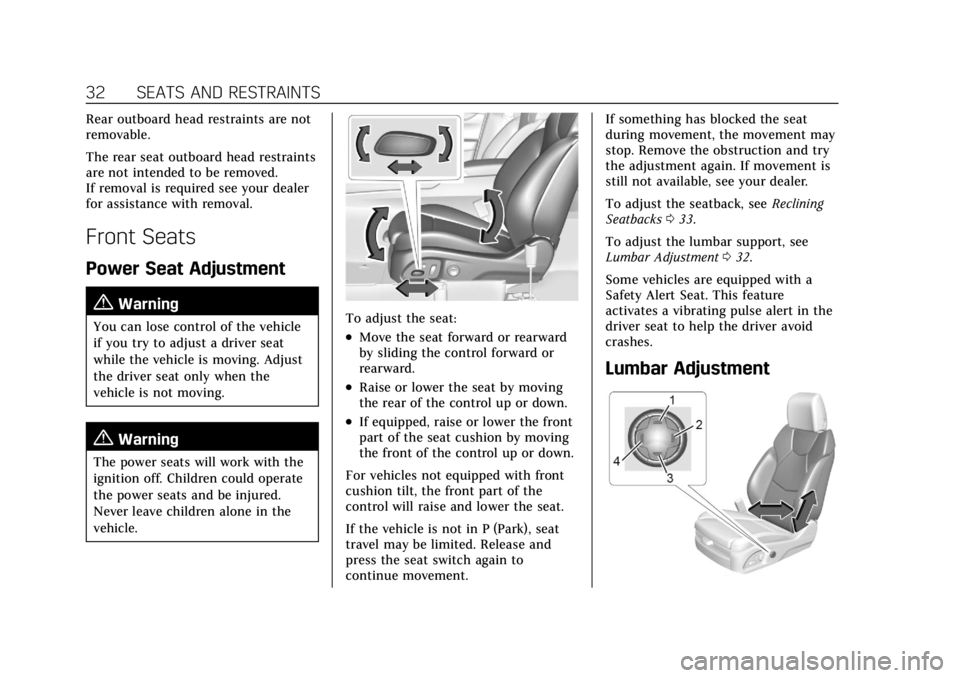
Cadillac CT4 Owner Manual (GMNA-Localizing-U.S./Canada-14584335) -
2021 - CRC - 11/23/20
32 SEATS AND RESTRAINTS
Rear outboard head restraints are not
removable.
The rear seat outboard head restraints
are not intended to be removed.
If removal is required see your dealer
for assistance with removal.
Front Seats
Power Seat Adjustment
{Warning
You can lose control of the vehicle
if you try to adjust a driver seat
while the vehicle is moving. Adjust
the driver seat only when the
vehicle is not moving.
{Warning
The power seats will work with the
ignition off. Children could operate
the power seats and be injured.
Never leave children alone in the
vehicle.
To adjust the seat:
.Move the seat forward or rearward
by sliding the control forward or
rearward.
.Raise or lower the seat by moving
the rear of the control up or down.
.If equipped, raise or lower the front
part of the seat cushion by moving
the front of the control up or down.
For vehicles not equipped with front
cushion tilt, the front part of the
control will raise and lower the seat.
If the vehicle is not in P (Park), seat
travel may be limited. Release and
press the seat switch again to
continue movement. If something has blocked the seat
during movement, the movement may
stop. Remove the obstruction and try
the adjustment again. If movement is
still not available, see your dealer.
To adjust the seatback, see
Reclining
Seatbacks 033.
To adjust the lumbar support, see
Lumbar Adjustment 032.
Some vehicles are equipped with a
Safety Alert Seat. This feature
activates a vibrating pulse alert in the
driver seat to help the driver avoid
crashes.
Lumbar Adjustment
Page 34 of 434
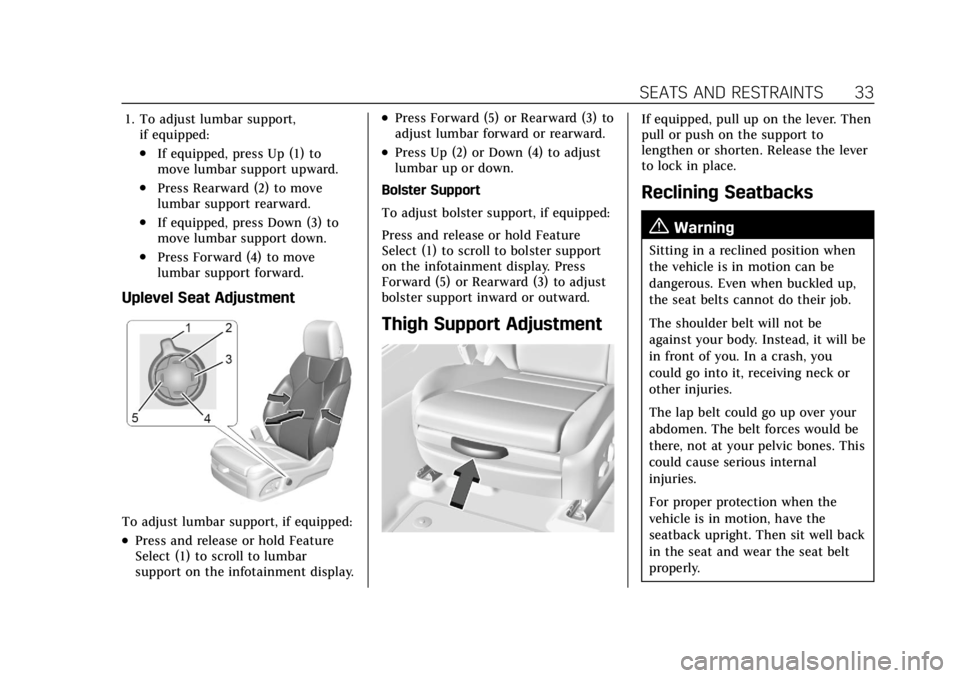
Cadillac CT4 Owner Manual (GMNA-Localizing-U.S./Canada-14584335) -
2021 - CRC - 11/23/20
SEATS AND RESTRAINTS 33
1. To adjust lumbar support,if equipped:
.If equipped, press Up (1) to
move lumbar support upward.
.Press Rearward (2) to move
lumbar support rearward.
.If equipped, press Down (3) to
move lumbar support down.
.Press Forward (4) to move
lumbar support forward.
Uplevel Seat Adjustment
To adjust lumbar support, if equipped:
.Press and release or hold Feature
Select (1) to scroll to lumbar
support on the infotainment display.
.Press Forward (5) or Rearward (3) to
adjust lumbar forward or rearward.
.Press Up (2) or Down (4) to adjust
lumbar up or down.
Bolster Support
To adjust bolster support, if equipped:
Press and release or hold Feature
Select (1) to scroll to bolster support
on the infotainment display. Press
Forward (5) or Rearward (3) to adjust
bolster support inward or outward.
Thigh Support Adjustment
If equipped, pull up on the lever. Then
pull or push on the support to
lengthen or shorten. Release the lever
to lock in place.
Reclining Seatbacks
{Warning
Sitting in a reclined position when
the vehicle is in motion can be
dangerous. Even when buckled up,
the seat belts cannot do their job.
The shoulder belt will not be
against your body. Instead, it will be
in front of you. In a crash, you
could go into it, receiving neck or
other injuries.
The lap belt could go up over your
abdomen. The belt forces would be
there, not at your pelvic bones. This
could cause serious internal
injuries.
For proper protection when the
vehicle is in motion, have the
seatback upright. Then sit well back
in the seat and wear the seat belt
properly.
Page 38 of 434
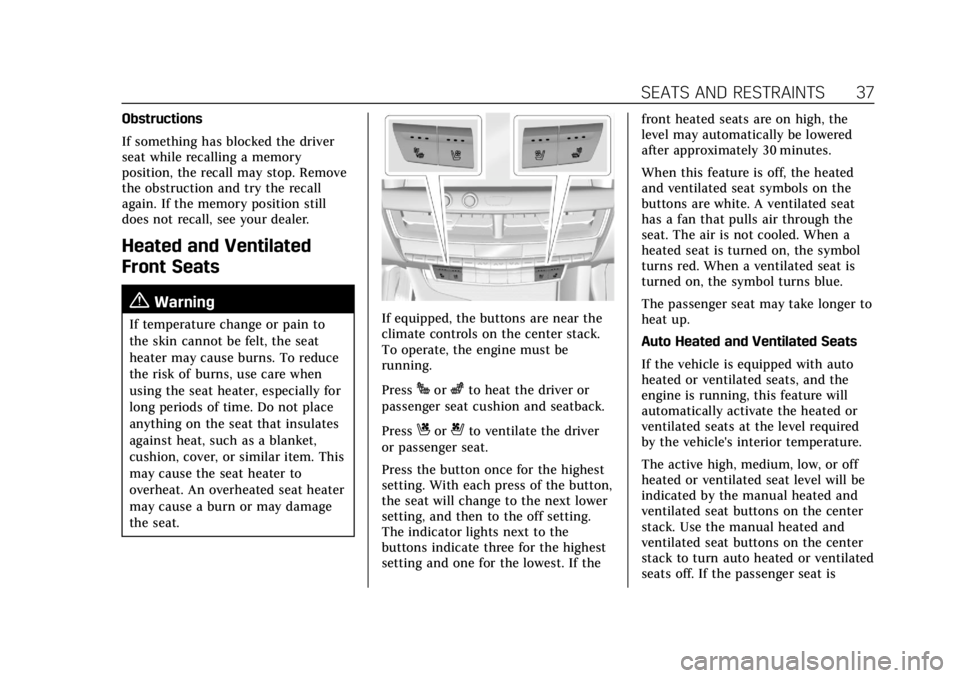
Cadillac CT4 Owner Manual (GMNA-Localizing-U.S./Canada-14584335) -
2021 - CRC - 11/23/20
SEATS AND RESTRAINTS 37
Obstructions
If something has blocked the driver
seat while recalling a memory
position, the recall may stop. Remove
the obstruction and try the recall
again. If the memory position still
does not recall, see your dealer.
Heated and Ventilated
Front Seats
{Warning
If temperature change or pain to
the skin cannot be felt, the seat
heater may cause burns. To reduce
the risk of burns, use care when
using the seat heater, especially for
long periods of time. Do not place
anything on the seat that insulates
against heat, such as a blanket,
cushion, cover, or similar item. This
may cause the seat heater to
overheat. An overheated seat heater
may cause a burn or may damage
the seat.If equipped, the buttons are near the
climate controls on the center stack.
To operate, the engine must be
running.
Press
Jorzto heat the driver or
passenger seat cushion and seatback.
Press
Cor{to ventilate the driver
or passenger seat.
Press the button once for the highest
setting. With each press of the button,
the seat will change to the next lower
setting, and then to the off setting.
The indicator lights next to the
buttons indicate three for the highest
setting and one for the lowest. If the front heated seats are on high, the
level may automatically be lowered
after approximately 30 minutes.
When this feature is off, the heated
and ventilated seat symbols on the
buttons are white. A ventilated seat
has a fan that pulls air through the
seat. The air is not cooled. When a
heated seat is turned on, the symbol
turns red. When a ventilated seat is
turned on, the symbol turns blue.
The passenger seat may take longer to
heat up.
Auto Heated and Ventilated Seats
If the vehicle is equipped with auto
heated or ventilated seats, and the
engine is running, this feature will
automatically activate the heated or
ventilated seats at the level required
by the vehicle's interior temperature.
The active high, medium, low, or off
heated or ventilated seat level will be
indicated by the manual heated and
ventilated seat buttons on the center
stack. Use the manual heated and
ventilated seat buttons on the center
stack to turn auto heated or ventilated
seats off. If the passenger seat is
Page 40 of 434
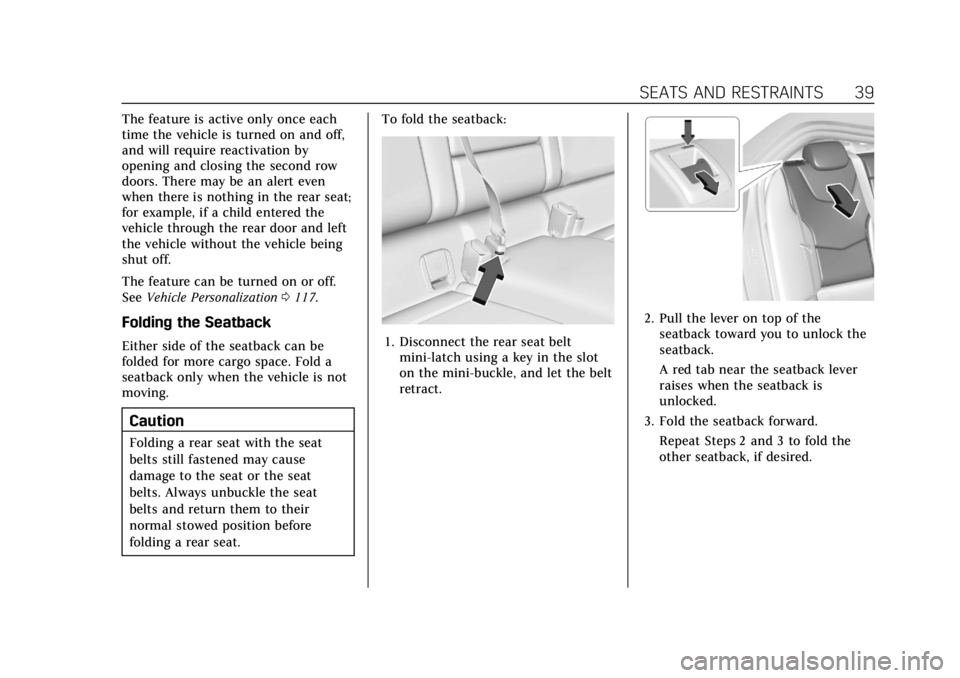
Cadillac CT4 Owner Manual (GMNA-Localizing-U.S./Canada-14584335) -
2021 - CRC - 11/23/20
SEATS AND RESTRAINTS 39
The feature is active only once each
time the vehicle is turned on and off,
and will require reactivation by
opening and closing the second row
doors. There may be an alert even
when there is nothing in the rear seat;
for example, if a child entered the
vehicle through the rear door and left
the vehicle without the vehicle being
shut off.
The feature can be turned on or off.
SeeVehicle Personalization 0117.
Folding the Seatback
Either side of the seatback can be
folded for more cargo space. Fold a
seatback only when the vehicle is not
moving.
Caution
Folding a rear seat with the seat
belts still fastened may cause
damage to the seat or the seat
belts. Always unbuckle the seat
belts and return them to their
normal stowed position before
folding a rear seat. To fold the seatback:
1. Disconnect the rear seat belt
mini-latch using a key in the slot
on the mini-buckle, and let the belt
retract.
2. Pull the lever on top of theseatback toward you to unlock the
seatback.
A red tab near the seatback lever
raises when the seatback is
unlocked.
3. Fold the seatback forward. Repeat Steps 2 and 3 to fold the
other seatback, if desired.
Page 41 of 434
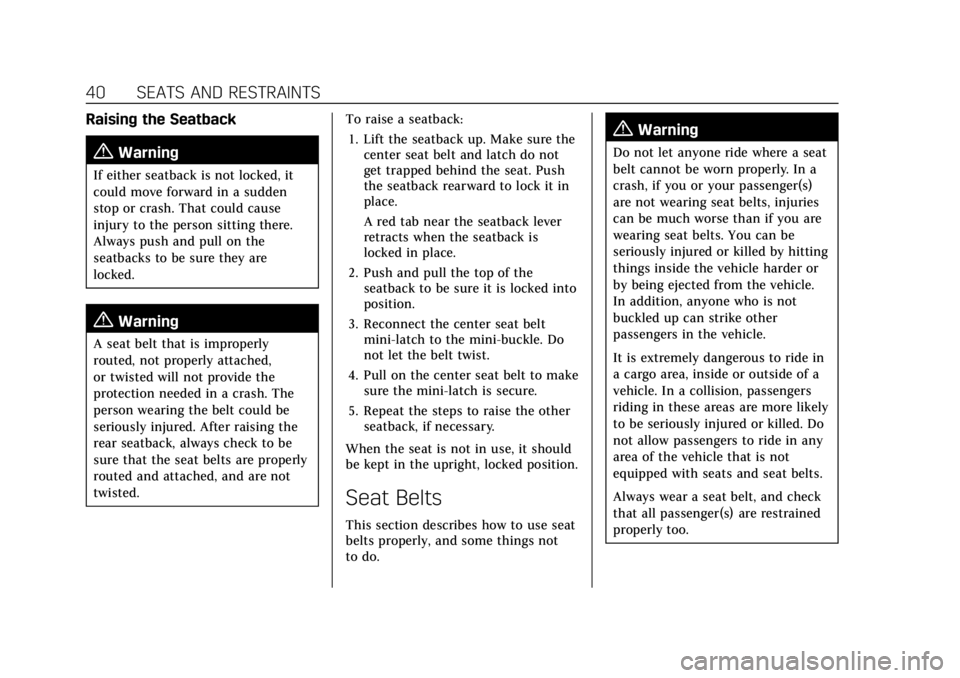
Cadillac CT4 Owner Manual (GMNA-Localizing-U.S./Canada-14584335) -
2021 - CRC - 11/23/20
40 SEATS AND RESTRAINTS
Raising the Seatback
{Warning
If either seatback is not locked, it
could move forward in a sudden
stop or crash. That could cause
injury to the person sitting there.
Always push and pull on the
seatbacks to be sure they are
locked.
{Warning
A seat belt that is improperly
routed, not properly attached,
or twisted will not provide the
protection needed in a crash. The
person wearing the belt could be
seriously injured. After raising the
rear seatback, always check to be
sure that the seat belts are properly
routed and attached, and are not
twisted.To raise a seatback:
1. Lift the seatback up. Make sure the center seat belt and latch do not
get trapped behind the seat. Push
the seatback rearward to lock it in
place.
A red tab near the seatback lever
retracts when the seatback is
locked in place.
2. Push and pull the top of the seatback to be sure it is locked into
position.
3. Reconnect the center seat belt mini-latch to the mini-buckle. Do
not let the belt twist.
4. Pull on the center seat belt to make sure the mini-latch is secure.
5. Repeat the steps to raise the other seatback, if necessary.
When the seat is not in use, it should
be kept in the upright, locked position.
Seat Belts
This section describes how to use seat
belts properly, and some things not
to do.
{Warning
Do not let anyone ride where a seat
belt cannot be worn properly. In a
crash, if you or your passenger(s)
are not wearing seat belts, injuries
can be much worse than if you are
wearing seat belts. You can be
seriously injured or killed by hitting
things inside the vehicle harder or
by being ejected from the vehicle.
In addition, anyone who is not
buckled up can strike other
passengers in the vehicle.
It is extremely dangerous to ride in
a cargo area, inside or outside of a
vehicle. In a collision, passengers
riding in these areas are more likely
to be seriously injured or killed. Do
not allow passengers to ride in any
area of the vehicle that is not
equipped with seats and seat belts.
Always wear a seat belt, and check
that all passenger(s) are restrained
properly too.
Page 43 of 434
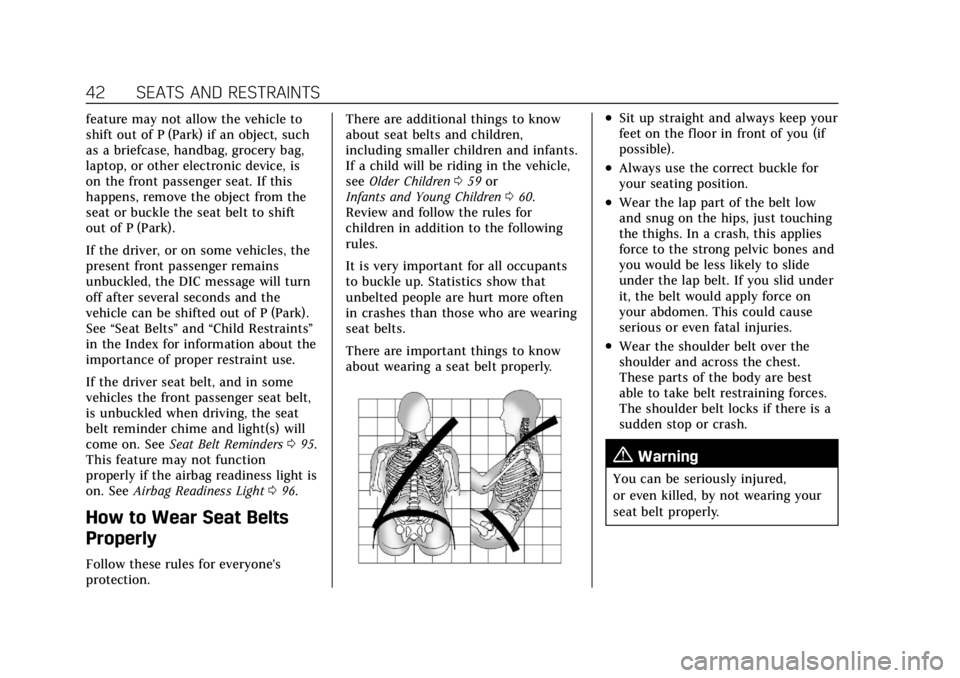
Cadillac CT4 Owner Manual (GMNA-Localizing-U.S./Canada-14584335) -
2021 - CRC - 11/23/20
42 SEATS AND RESTRAINTS
feature may not allow the vehicle to
shift out of P (Park) if an object, such
as a briefcase, handbag, grocery bag,
laptop, or other electronic device, is
on the front passenger seat. If this
happens, remove the object from the
seat or buckle the seat belt to shift
out of P (Park).
If the driver, or on some vehicles, the
present front passenger remains
unbuckled, the DIC message will turn
off after several seconds and the
vehicle can be shifted out of P (Park).
See“Seat Belts” and“Child Restraints”
in the Index for information about the
importance of proper restraint use.
If the driver seat belt, and in some
vehicles the front passenger seat belt,
is unbuckled when driving, the seat
belt reminder chime and light(s) will
come on. See Seat Belt Reminders 095.
This feature may not function
properly if the airbag readiness light is
on. See Airbag Readiness Light 096.
How to Wear Seat Belts
Properly
Follow these rules for everyone's
protection. There are additional things to know
about seat belts and children,
including smaller children and infants.
If a child will be riding in the vehicle,
see
Older Children 059 or
Infants and Young Children 060.
Review and follow the rules for
children in addition to the following
rules.
It is very important for all occupants
to buckle up. Statistics show that
unbelted people are hurt more often
in crashes than those who are wearing
seat belts.
There are important things to know
about wearing a seat belt properly.
.Sit up straight and always keep your
feet on the floor in front of you (if
possible).
.Always use the correct buckle for
your seating position.
.Wear the lap part of the belt low
and snug on the hips, just touching
the thighs. In a crash, this applies
force to the strong pelvic bones and
you would be less likely to slide
under the lap belt. If you slid under
it, the belt would apply force on
your abdomen. This could cause
serious or even fatal injuries.
.Wear the shoulder belt over the
shoulder and across the chest.
These parts of the body are best
able to take belt restraining forces.
The shoulder belt locks if there is a
sudden stop or crash.
{Warning
You can be seriously injured,
or even killed, by not wearing your
seat belt properly.
Page 45 of 434
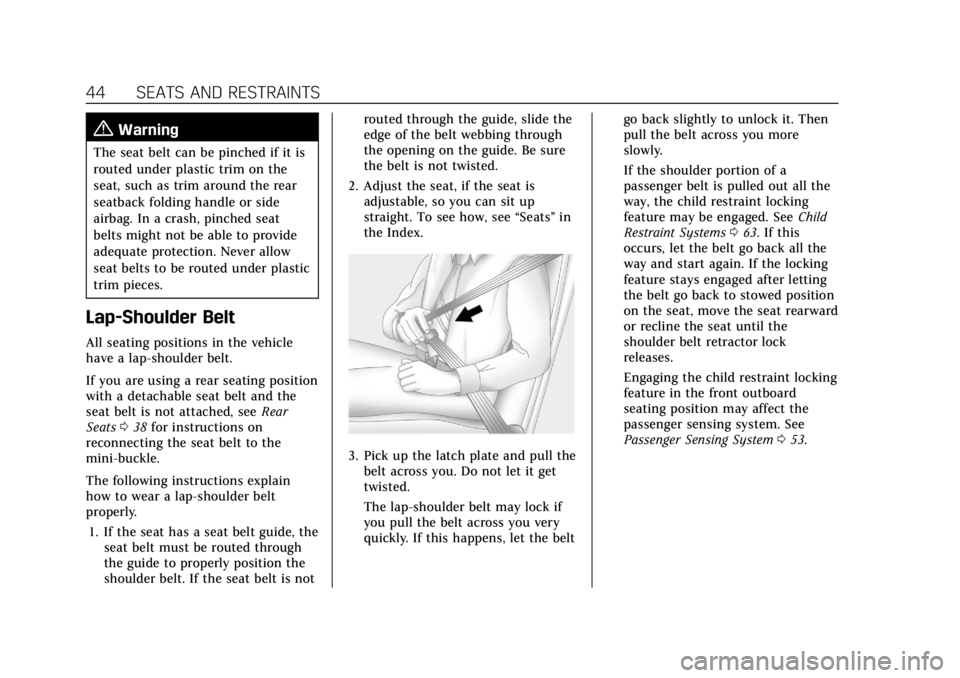
Cadillac CT4 Owner Manual (GMNA-Localizing-U.S./Canada-14584335) -
2021 - CRC - 11/23/20
44 SEATS AND RESTRAINTS
{Warning
The seat belt can be pinched if it is
routed under plastic trim on the
seat, such as trim around the rear
seatback folding handle or side
airbag. In a crash, pinched seat
belts might not be able to provide
adequate protection. Never allow
seat belts to be routed under plastic
trim pieces.
Lap-Shoulder Belt
All seating positions in the vehicle
have a lap-shoulder belt.
If you are using a rear seating position
with a detachable seat belt and the
seat belt is not attached, seeRear
Seats 038 for instructions on
reconnecting the seat belt to the
mini-buckle.
The following instructions explain
how to wear a lap-shoulder belt
properly.
1. If the seat has a seat belt guide, the seat belt must be routed through
the guide to properly position the
shoulder belt. If the seat belt is not routed through the guide, slide the
edge of the belt webbing through
the opening on the guide. Be sure
the belt is not twisted.
2. Adjust the seat, if the seat is adjustable, so you can sit up
straight. To see how, see “Seats”in
the Index.
3. Pick up the latch plate and pull the belt across you. Do not let it get
twisted.
The lap-shoulder belt may lock if
you pull the belt across you very
quickly. If this happens, let the belt go back slightly to unlock it. Then
pull the belt across you more
slowly.
If the shoulder portion of a
passenger belt is pulled out all the
way, the child restraint locking
feature may be engaged. See
Child
Restraint Systems 063. If this
occurs, let the belt go back all the
way and start again. If the locking
feature stays engaged after letting
the belt go back to stowed position
on the seat, move the seat rearward
or recline the seat until the
shoulder belt retractor lock
releases.
Engaging the child restraint locking
feature in the front outboard
seating position may affect the
passenger sensing system. See
Passenger Sensing System 053.
Page 46 of 434
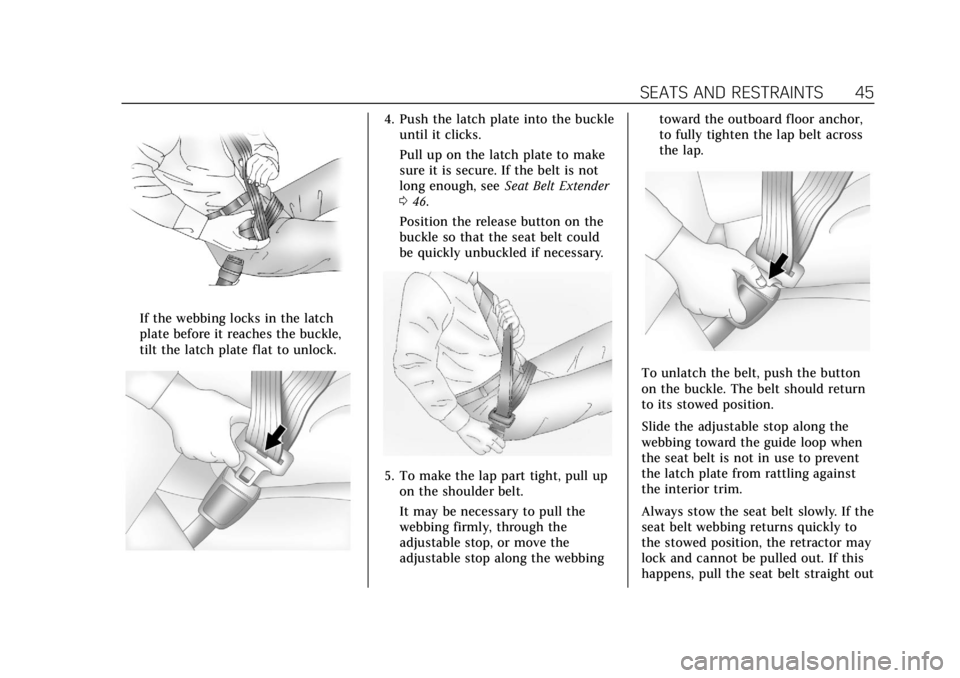
Cadillac CT4 Owner Manual (GMNA-Localizing-U.S./Canada-14584335) -
2021 - CRC - 11/23/20
SEATS AND RESTRAINTS 45
If the webbing locks in the latch
plate before it reaches the buckle,
tilt the latch plate flat to unlock.
4. Push the latch plate into the buckleuntil it clicks.
Pull up on the latch plate to make
sure it is secure. If the belt is not
long enough, see Seat Belt Extender
0 46.
Position the release button on the
buckle so that the seat belt could
be quickly unbuckled if necessary.
5. To make the lap part tight, pull up on the shoulder belt.
It may be necessary to pull the
webbing firmly, through the
adjustable stop, or move the
adjustable stop along the webbing toward the outboard floor anchor,
to fully tighten the lap belt across
the lap.
To unlatch the belt, push the button
on the buckle. The belt should return
to its stowed position.
Slide the adjustable stop along the
webbing toward the guide loop when
the seat belt is not in use to prevent
the latch plate from rattling against
the interior trim.
Always stow the seat belt slowly. If the
seat belt webbing returns quickly to
the stowed position, the retractor may
lock and cannot be pulled out. If this
happens, pull the seat belt straight out
Page 47 of 434
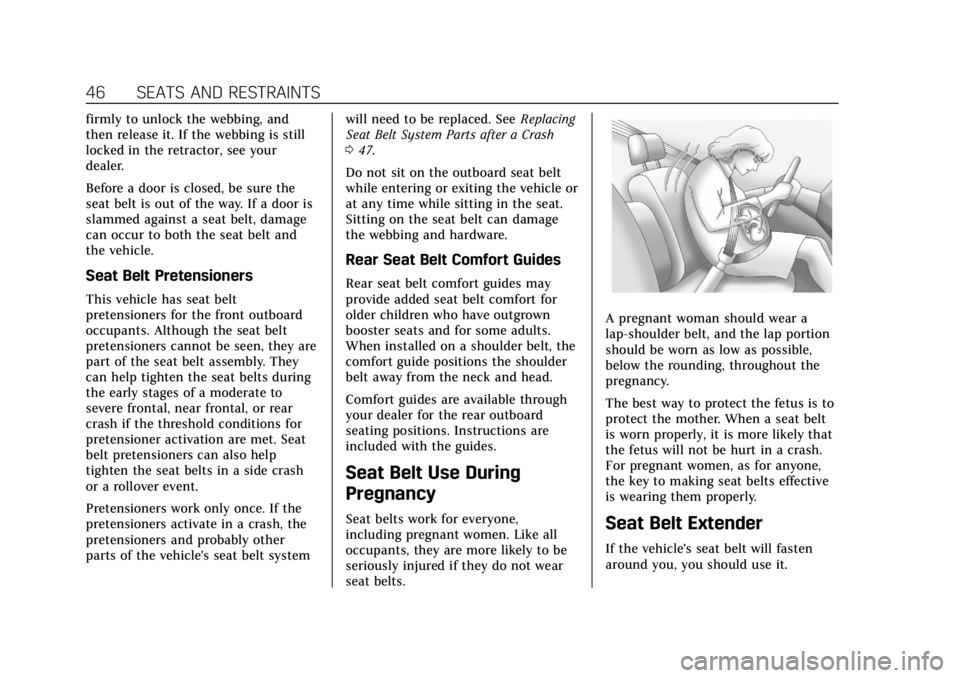
Cadillac CT4 Owner Manual (GMNA-Localizing-U.S./Canada-14584335) -
2021 - CRC - 11/23/20
46 SEATS AND RESTRAINTS
firmly to unlock the webbing, and
then release it. If the webbing is still
locked in the retractor, see your
dealer.
Before a door is closed, be sure the
seat belt is out of the way. If a door is
slammed against a seat belt, damage
can occur to both the seat belt and
the vehicle.
Seat Belt Pretensioners
This vehicle has seat belt
pretensioners for the front outboard
occupants. Although the seat belt
pretensioners cannot be seen, they are
part of the seat belt assembly. They
can help tighten the seat belts during
the early stages of a moderate to
severe frontal, near frontal, or rear
crash if the threshold conditions for
pretensioner activation are met. Seat
belt pretensioners can also help
tighten the seat belts in a side crash
or a rollover event.
Pretensioners work only once. If the
pretensioners activate in a crash, the
pretensioners and probably other
parts of the vehicle's seat belt systemwill need to be replaced. See
Replacing
Seat Belt System Parts after a Crash
0 47.
Do not sit on the outboard seat belt
while entering or exiting the vehicle or
at any time while sitting in the seat.
Sitting on the seat belt can damage
the webbing and hardware.
Rear Seat Belt Comfort Guides
Rear seat belt comfort guides may
provide added seat belt comfort for
older children who have outgrown
booster seats and for some adults.
When installed on a shoulder belt, the
comfort guide positions the shoulder
belt away from the neck and head.
Comfort guides are available through
your dealer for the rear outboard
seating positions. Instructions are
included with the guides.
Seat Belt Use During
Pregnancy
Seat belts work for everyone,
including pregnant women. Like all
occupants, they are more likely to be
seriously injured if they do not wear
seat belts.
A pregnant woman should wear a
lap-shoulder belt, and the lap portion
should be worn as low as possible,
below the rounding, throughout the
pregnancy.
The best way to protect the fetus is to
protect the mother. When a seat belt
is worn properly, it is more likely that
the fetus will not be hurt in a crash.
For pregnant women, as for anyone,
the key to making seat belts effective
is wearing them properly.
Seat Belt Extender
If the vehicle's seat belt will fasten
around you, you should use it.
Page 52 of 434
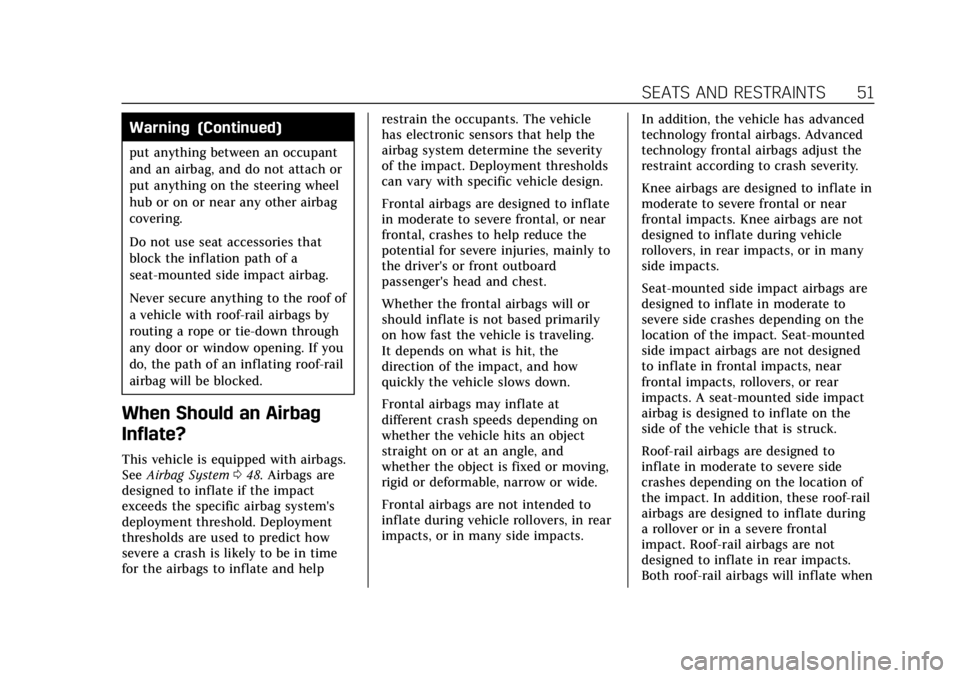
Cadillac CT4 Owner Manual (GMNA-Localizing-U.S./Canada-14584335) -
2021 - CRC - 11/23/20
SEATS AND RESTRAINTS 51
Warning (Continued)
put anything between an occupant
and an airbag, and do not attach or
put anything on the steering wheel
hub or on or near any other airbag
covering.
Do not use seat accessories that
block the inflation path of a
seat-mounted side impact airbag.
Never secure anything to the roof of
a vehicle with roof-rail airbags by
routing a rope or tie‐down through
any door or window opening. If you
do, the path of an inflating roof-rail
airbag will be blocked.
When Should an Airbag
Inflate?
This vehicle is equipped with airbags.
SeeAirbag System 048. Airbags are
designed to inflate if the impact
exceeds the specific airbag system's
deployment threshold. Deployment
thresholds are used to predict how
severe a crash is likely to be in time
for the airbags to inflate and help restrain the occupants. The vehicle
has electronic sensors that help the
airbag system determine the severity
of the impact. Deployment thresholds
can vary with specific vehicle design.
Frontal airbags are designed to inflate
in moderate to severe frontal, or near
frontal, crashes to help reduce the
potential for severe injuries, mainly to
the driver's or front outboard
passenger's head and chest.
Whether the frontal airbags will or
should inflate is not based primarily
on how fast the vehicle is traveling.
It depends on what is hit, the
direction of the impact, and how
quickly the vehicle slows down.
Frontal airbags may inflate at
different crash speeds depending on
whether the vehicle hits an object
straight on or at an angle, and
whether the object is fixed or moving,
rigid or deformable, narrow or wide.
Frontal airbags are not intended to
inflate during vehicle rollovers, in rear
impacts, or in many side impacts.
In addition, the vehicle has advanced
technology frontal airbags. Advanced
technology frontal airbags adjust the
restraint according to crash severity.
Knee airbags are designed to inflate in
moderate to severe frontal or near
frontal impacts. Knee airbags are not
designed to inflate during vehicle
rollovers, in rear impacts, or in many
side impacts.
Seat-mounted side impact airbags are
designed to inflate in moderate to
severe side crashes depending on the
location of the impact. Seat-mounted
side impact airbags are not designed
to inflate in frontal impacts, near
frontal impacts, rollovers, or rear
impacts. A seat-mounted side impact
airbag is designed to inflate on the
side of the vehicle that is struck.
Roof-rail airbags are designed to
inflate in moderate to severe side
crashes depending on the location of
the impact. In addition, these roof-rail
airbags are designed to inflate during
a rollover or in a severe frontal
impact. Roof-rail airbags are not
designed to inflate in rear impacts.
Both roof-rail airbags will inflate when